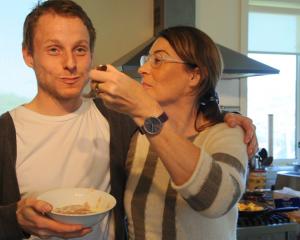After working at Larnach Castle and Scotia, he did a bachelor of culinary arts degree looking at how small-scale production, such as the smoked fish and other products he sells at the Otago Farmers Market, can be scaled up for a national market without losing their integrity.
This way of cooking fish developed out of a friendly rivalry between him and his brother over who has caught the best fish and has the best gardening skills. The fish must be spanking fresh and the herbs just picked.
It can also be cooked on the beach or the river bank where you caught the fish, though you might need to bring your herbs with you, unless wild ones happen to be growing nearby.
Method
If you have a flat fish like flounder, cut a slit in the top to the backbone and along the ribs to form a small pocket.
If you have a round fish, just use the gut cavity, but make sure the gills are removed or they will flavour the fish.
Put a knob or two of butter in the cavity. Fold a few fresh herbs and put them in too, no need to chop them.
Place a piece of greaseproof paper over a square of aluminium foil and place the fish on it.
Fold the foil into a loose parcel, folding over the edges to seal them.
Tim prefers to cook the fish on a charcoal barbecue, but a gas one will do. Keep the heat medium to low by lighting the burners on each side but not in the middle where you will cook the fish.
It will take about 15-20 minutes. To check if it is cooked, feel the parcel. It should be warm and the fish should feel soft through the tinfoil. It should be just beginning to flake. If in doubt, open the parcel to check.
Tim likes to serve the fish simply, perhaps with a salad from the garden and maybe a squeeze of lemon juice if you have one. Some people like to sprinkle soy sauce on it.
To serve, open the parcel and with a knife and fork lift the flesh off the fish and place beside it. Then lift the flesh off the skin and eat it. To eat the bottom half, use snips to cut the backbone and lift it off.
The ingredients are not precise, but you will need:
fresh whole fish, cleaned
a handful or two of fresh herbs
a few knobs of butter or a drizzle of olive oil
greaseproof paper
aluminium foil.
Tips
• If you are using a round fish such as blue cod, moki, trumpeter or terakihi, make sure the gills are removed or their flavour will permeate the fish as it cooks. It's also good with trout and salmon.
• If the herbs are strongly flavoured, such as rosemary, you will need less.
• Tim likes to use greaseproof paper so the fish does not come in contact with the aluminium.
• If open fires are allowed, you can dig a hole in the beach or river bank, light a small fire and when the flames die down, put in the fish parcels, preferably on a rack, cover the hole like a mini umu and allow the fish to cook. Make sure the fire is put out when you have finished.
• You can also cook this in an oven at 100-120degC or a Dutch oven on the stove top, but take care not to burn the bottom of the fish.
• Tim says many people overcook fish so it becomes tough and dry. It should be about 50degC inside and the fish should feel soft to the touch and just start to flake as you press a finger into it.
• You don't need to season this dish, as freshly caught fish retains some of its salt.
Thanks to Afife Harris and Centre City New World.







